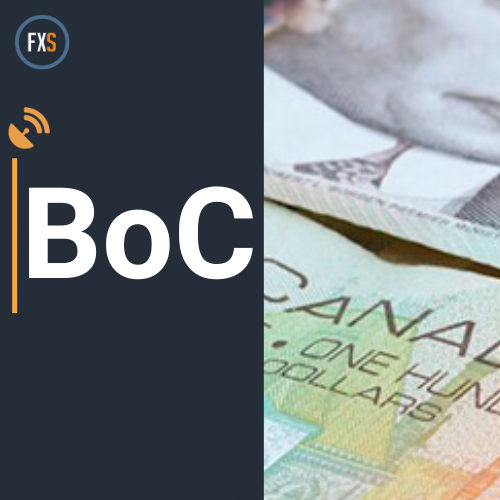- The Bank of Canada is forecast to leave the policy rate unchanged at 5.0% on Wednesday.
- BoC policymakers are expected to keep the interest rate steady until the end of the year.
- BoC projections could ramp up volatility around the Canadian Dollar.
The Bank of Canada (BoC) is widely expected to leave its policy rate unchanged at 5% for the second consecutive time on Wednesday, when it concludes the October policy meeting. The Canadian Dollar (CAD) has been steadily weakening against the US Dollar (USD) since the BoC’s last rate increase in July, with the USD/CAD pair gaining nearly 4% since the beginning of August.
The BoC’s latest Business Outlook Survey (BoS), published on October 16, showed that more than 70% of firms across a broad range of sectors said that higher interest rates were negatively affecting them.
“Consumers’ perceptions of current inflation remain elevated and are leading to persistently high expectations for inflation over the next 12 months,” the BoC noted in the Canadian Survey of Consumer Expectations released alongside the BoS. “Consumers’ expectations for interest rates one year from now also remain high. Many people think increases in interest rates are raising the cost of living and keeping inflation high,” the publication read.
Bank of Canada interest rate expectations: Steady policy as inflation slows
Inflation in Canada, as measured by the change in the Consumer Price Index (CPI), declined to 3.8% on a yearly basis in September from 4% in August, Statistics Canada reported earlier in the month. The Core CPI, which excludes volatile food and energy prices, rose 2.8% in the same period, at a softer pace than the 3.3% increase recorded in August.
Commenting on inflation developments, Bank of Canada Governor Tiff Macklem said on Friday that they were concerned because they were not really seeing a downward momentum in inflation. “When Governing Council next meets, it will focus on whether to stick with its 5% rate or if more action is needed to restore price stability,” Macklem added.
After leaving the policy rate unchanged at 5% in September, the BoC said it is prepared to raise rates again if needed, citing concerns over the persistence of underlying inflationary pressures.
The BoC is unlikely to go against market expectations and raise the interest rate. Almost all analysts polled by Reuters (29 of 32) said that they forecast the BoC to hold the policy rate steady at 5%. Policymakers are likely to see growing signs of cooling in the housing market and the overall economic activity as a reason to stay on the sidelines and wait for more data. According to the Canadian Real Estate Association, national home sales declined by 1.9% month-over-month in September, marking the third consecutive contraction. Meanwhile, real Gross Domestic Product stagnated in July, following the 0.2% monthly contraction recorded in June.
Nevertheless, inflation remains the primary concern for the BoC and it wouldn’t be surprising to see the bank leaving additional policy tightening on the table for future meetings. Revisions to inflation and growth forecasts will also be scrutinized by market participants.
Economists at the National Bank of Canada think there is room for a hawkish surprise:
“In light of recent data, we expect the Bank of Canada to leave its overnight target unchanged for the second consecutive meeting on Wednesday. Saying that, there remain some problematic elements of the inflation outlook that might argue for additional tightening and as such, we’d caution that this is not an open-and-shut decision.”
“At a minimum, policymakers will leave the door open to further tightening via an explicit threat to hike further. That hiking bias will likely remain until more durable progress on inflation is made. Wednesday’s rate statement will be published alongside an updated Monetary Policy Report. Here you’ll see a material downgrade to the GDP trajectory and an inflation profile that will need to be marked up to reflect stronger-than-expected price pressures in the summer.”
When will the BoC release its monetary policy decision and how could it affect USD/CAD?
The Bank of Canada will announce its policy decision at 14:00 GMT. The policy decisions will be accompanied by the central bank’s updated forecasts and there will be a press conference by Governor Tiff Macklem following the release of the policy statement.
A hawkish policy hold could help the CAD gather strength against the USD with the immediate reaction and trigger a downward correction in USD/CAD. In this scenario, whether the pair starts a steady downtrend will largely depend on the USD’s valuation.
An unexpected 25 bps rate hike is likely to fuel a CAD rally and cause the pair to fall sharply. The least likely scenario is a dovish surprise, with the BoC removing the reference about readiness to raise the policy rate again from the statement. If that were to materialize, USD/CAD could gather bullish momentum and extend its uptrend.
Eren Sengezer, European Session Lead Analyst at FXStreet, offers a brief technical outlook for the USD/CAD pair and writes: “The Relative Strength Index (RSI) indicator on the daily chart holds comfortably above 50, reflecting the lack of seller interest. On the upside, 1.3800 (static level, psychological level) aligns as first resistance. With a daily close above this level, USD/CAD can extend its uptrend and face interim resistance at 1.3860 (March 10 high) before targeting 1.3980 (October 13, 2022, high). Looking south, the 50-day Simple Moving Average (SMA) forms dynamic support at 1.3600 before 1.3500-1.3480 (psychological level, 200-day SMA).”
Economic Indicator
Canada BoC Interest Rate Decision
BoC Interest Rate Decision is announced by the Bank of Canada. If the BoC is hawkish about the inflationary outlook of the economy and rises the interest rates it is positive, or bullish, for the CAD. Likewise, if the BoC has a dovish view on the Canadian economy and keeps the ongoing interest rate, or cuts the interest rate it is seen as negative, or bearish.









